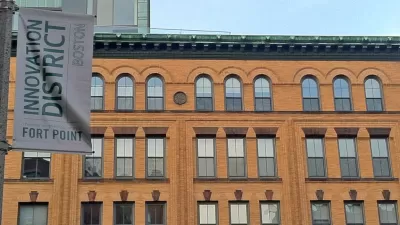A new report by Bruce Katz of Brookings Institute discusses the federal government’s role in spurring and aiding the innovation districts found in many cities across the country today.
In response to the U.S. Office of Science and Technology Policy, Bruce Katz of Brookings Institute argues, "The federal government should not attempt to lead the development of innovation districts. Successful districts do not emerge from a federal program like empowerment zones but rather from the collaborative efforts of local institutions and leaders and organic market dynamics. In addition, the emerging districts around the country differ markedly in their leadership structure, sector orientation, and existing economic, physical and networking assets—obviating any one 'one size fits all' response."
While Katz does not believe in one blanket policy to support all innovation districts, he offers three main ways the federal government can support these districts. The first is through continuing funding to basic and applied research at the major anchor institutions associated with innovation districts. For example, MIT "relies on the federal government for roughly 70 percent of its research funding—$466 million in 2013. This federally-backed research creates a platform for commercialization, which spurs job creation and entrepreneurial growth and brings technological advances to our businesses and homes."
In addition, Katz also uses the decision to locate the American Lightweight Metals Manufacturing Institute in Detroit as having "the potential to not only spur innovative commercialization and strengthen an important regional cluster but also to supercharge the revitalization of communities though the growth of housing, retail establishments and quality place-making."
The second policy recommendation Katz offers is for the federal government to "encourage a more robust school-to-work pipeline for sub-baccalaureate workers. Given the proximity of innovation districts to low-income neighborhoods… there is the demand for targeted federal efforts to underwrite STEM-oriented schools that offer apprenticeship opportunities."
Finally, Katz also strongly pushes for the federal government to support infrastructure and housing initiatives surrounding the innovation districts. As Katz writes, "the primary imperative is to reestablish the federal government as a reliable, consistent, and flexible partner in these arenas, both with regard to tax incentives… and discretionary and credit enhancement programs around housing, transportation, and sustainable development."
FULL STORY: What Should the Role of The Federal Government Be in Supporting Innovation Districts?

Alabama: Trump Terminates Settlements for Black Communities Harmed By Raw Sewage
Trump deemed the landmark civil rights agreement “illegal DEI and environmental justice policy.”

Planetizen Federal Action Tracker
A weekly monitor of how Trump’s orders and actions are impacting planners and planning in America.

How Atlanta Built 7,000 Housing Units in 3 Years
The city’s comprehensive, neighborhood-focused housing strategy focuses on identifying properties and land that can be repurposed for housing and encouraging development in underserved neighborhoods.

In Both Crashes and Crime, Public Transportation is Far Safer than Driving
Contrary to popular assumptions, public transportation has far lower crash and crime rates than automobile travel. For safer communities, improve and encourage transit travel.

Report: Zoning Reforms Should Complement Nashville’s Ambitious Transit Plan
Without reform, restrictive zoning codes will limit the impact of the city’s planned transit expansion and could exclude some of the residents who depend on transit the most.

Judge Orders Release of Frozen IRA, IIJA Funding
The decision is a victory for environmental groups who charged that freezing funds for critical infrastructure and disaster response programs caused “real and irreparable harm” to communities.
Urban Design for Planners 1: Software Tools
This six-course series explores essential urban design concepts using open source software and equips planners with the tools they need to participate fully in the urban design process.
Planning for Universal Design
Learn the tools for implementing Universal Design in planning regulations.
Jessamine County Fiscal Court
Caltrans
Institute for Housing and Urban Development Studies (IHS)
City of Grandview
Harvard GSD Executive Education
Toledo-Lucas County Plan Commissions
Salt Lake City
NYU Wagner Graduate School of Public Service




























